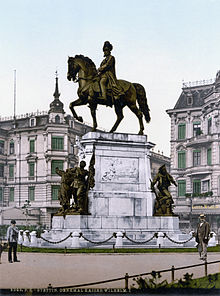 The William I Monument in 1900. The William I Monument in 1900. | |
| 53°25′43.4″N 14°33′10.6″E / 53.428722°N 14.552944°E / 53.428722; 14.552944 | |
| Location | Polish Soldier Square, Szczecin, Poland |
|---|---|
| Designer | Karl Hilgers |
| Type | Equestrian statue |
| Material | Bronze, stone |
| Opening date | 1 November 1894 |
| Dedicated to | William I |
| Dismantled date | 31 July 1945 |
The William I Monument was a monument in Szczecin, Poland, in form of an equestrian statue of William I, emperor of Germany from 1871 to 1888. It was designed by sculptor Karl Hilgers and unveiled on 1 November 1894 at the King Square (now Polish Soldier Square). The monument was dismantled on 31 July 1945.
History

On 1 November 1894, at the King Square (now known as the Polish Soldier Square) the monument dedicated to William I, emperor of Germany from 1871 to 1888, was unveiled. It was designed by sculptor Karl Hilgers and manufactured by Berlin-based company Schäffer und Walker. The monument was funded from the donations from city inhabitants. It consisted of a bronze statue of the emperor on a horse, placed on a stone pedestal, with bronze sculptures of the soldiers around it.
During World War II, the statues of the soldiers in the William I Monument were taken down to be melted for materials. After the end of the war, on 31 July 1945, the monument was torn down by the Polish inhabitants of the city. The statue was then taken to Denmark and melted. It was used to manufacture a replica of the Prince Józef Antoni Poniatowski Monument in Warsaw, which was destroyed during the war.
In its place, on 26 April 1950, was unveiled the Monument of Graduate to the Soviet Army. It was deconstructed in November 2017.
Characteristics
The monument was placed at the northern end of the King Square (now Polish Soldier Square) and at the beginning of Emperor William Street (now John Paul II Avenue). It included a bronze statue of the emperor William I on a horse, wearing a military uniform and a helmet with a war bonnet. It was placed on a white stone Gothic Revivial pedestal, with depictions of historical scenes on its walls. Around its corners were placed bronze statues of the soldiers.
Notes
References
- ^ Encyklopedia Szczecina, vol. 2: P–Ż. Szczecin: University of Szczecin, 2000, p. 151–154. ISBN 83-7241-089-5. (in Polish)
- Hanna Kotkowska-Bareja: Pomnik Poniatowskiego. Warsaw: Państwowe Wydawnictwo Naukowe, 1971, p. 72. (in Polis)
- "Pomnik Wdzięczności dla Armii Czerwonej zniknął. Taka jest teraz perspektywa al. Papieża Jana Pawła II [ZDJĘCIA]". szczecin.wyborcza pl (in Polish). 19 November 2017.
External links
 Media related to William I Monument at Wikimedia Commons
Media related to William I Monument at Wikimedia Commons
- 1894 sculptures
- 1884 establishments in Germany
- Buildings and structures completed in 1884
- Equestrian statues in Poland
- Monuments and memorials in Szczecin
- Outdoor sculptures in Szczecin
- Statues of monarchs
- Statues of men in Poland
- Centrum, Szczecin
- 1945 disestablishments in Poland
- Buildings and structures demolished in 1945
- Former buildings and structures in Szczecin
- Removed statues
- Stone monuments and memorials
- Bronze sculptures in Poland
- Gothic Revival architecture in Poland
- Monuments and memorials to Emperor William I
- Destroyed sculptures